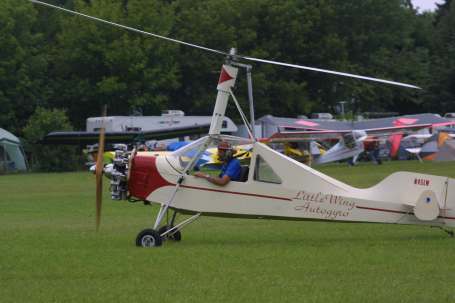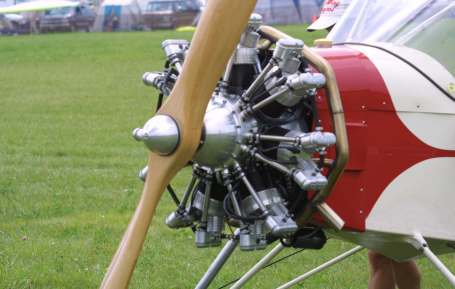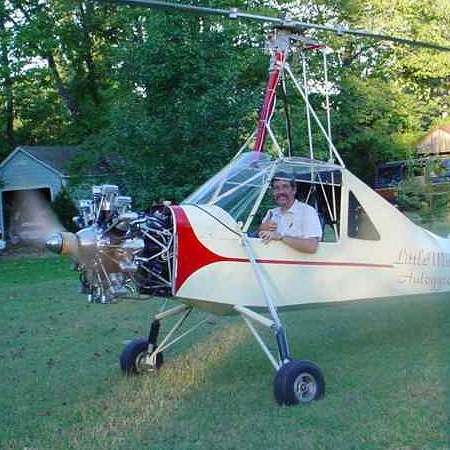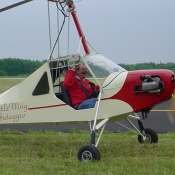
"Yeah. It's got a radial."
The Following Article was written in collaboration by Bruce Charnov & Ron Herron (19 August 2002)
This article is scheduled to appear in Rotorcraft magazine in the very near future, for information contact editor Kathy Fields or log onto the Popular Rotorcraft Association website.
The Rotec R 2800 Radial Engine:
Back to the Future
Dr. Bruce Charnov, Hofstra University
Harold F. Pitcairn purchased a Cierva C.8 Mk.IV Autogiro in the summer of 1928 after being assured by Juan de la Cierva’s English engineers that the rotor would function when the original 180 - hp 7-cylinder radial Armstrong Siddeley Lynx IV engine was replaced by an American 220 -hp Wright Whirlwind radial engine. (1) Pitcairn’s insistence may have come from the fact that Lindbergh’s Spirit of St. Louis had been powered by a J-5 (2) or that all but one of his famed Mailwing series had been powered by Wright J-5 series engines (3).
The C.8W (NC418) was reassembled at Pitcairn Field, Bryn Athyn Field, PA and flown by Cierva pilot Arthur “Dizzy” Rawson on December 18, 1928, and then flown by Pitcairn, although there is some confusion as to when the Pitcairn flight actually occurred. Pitcairn company historian Carl Gunther claims (4) that Pitcairn flew immediately after Rawson on the 18th, but the Autogiro Company of America 1932’s publication maintained that the first flight occurred (5) both on December 18th and 19th ! Assuming that the 18th is correct, it was twenty-five years and a day since the Wright brothers first flew - the age of rotary wing flight had come to America. And it arrived powered by a radial engine. All of the American Autogiros built by Pitcairn, Kellett and Buhl were powered by radials, the engines being Wright, Pratt & Whitney, Kinner, Pobjoy, Warner Super Scarab, Continental, and Jacobs (the only exception was the single unsuccessful Pitcairn PAA-2 built with a Martin Chevrolet engine).
Australians Matthew and Paul Chernikeeff have gone back to the future with their introduction at AirVenture 2002 of the Rotec Engineering R 2800 radial engine (website http://www.rotecradialengines.com/) which is being distributed in America by Custom Craft LLC of Boggstown, Indiana (website http://www.radialpower.com/) owned by Brian Henneman. Manufactured in Australia, this is a sleek 7-cylinder 2,800 cc four-stroke radial engine. Weighing in at 220 pounds (dry weight including bolt-on engine accessories) and rated at 110-hp @3,700 rpm, and assuming a cost between $13,000 - $15,000, this works out to $118.00 - $136.36/hp, a choice that will clearly not be for everyone, but for those who desire such an engine, they will acquire a beautifully-made product. The machined aluminum crankcase and heads actually gleam! The steel 4140 billet crankshaft, nitride hardened and ground, runs on two large anti-friction roller bearings, and 4140 steel is also used for the cylinders and master and link rods. This engine is tough!
The Rotec R2800 incorporates a 3/2 Internal Planetary Speed Reduction Unit (PSRU) that throws a fixed 70 – 76” diameter 44 – 55” pitch propeller @ 2,400 rpm. The propeller flange specs are standard SAE #2 (identical with the Rotax 912 series). Influenced by successful radial designs of the past, the Chernikeeff brothers have made use of two push rod operated overhead valves for each cylinder head fired by a dual electronic magneto ignition with a single Bing 40 mm constant depression pressure compensated carburetor. The designers have emphasized safety by utilizing both two auto-type spark plugs per cylinder independently fired by both a single self-energized magneto and a Hall-effect 12 volt electronic ignition system – a deliberate redundancy to eliminate the possibility of total engine failure. And, in keeping with the focus on safety, the designers recommend that the homebuilder add an electric fuel pump as backup to the supplied engine driven mechanical fuel pump, suggesting that both pumps be configured in series. With an Avgas 100LL aviation or high octane mogas consumption of 5 gal/hr @75% power, the highly finished engine shows a distinguished lineage from the 7-cylinder Clerget, Gnome and Wright rotary radial engines and effectively recaptures, in the words of its promotional literature “the yesteryear romanticism of the radial engine while, at the same time, combine modern design and production techniques to yield a truly unique product.” The workmanship on the engine is superb – all cams and bearing surfaces are nitride hardened and precision ground to exact tolerances. Recommended TBO is a conservative 1000 hours and all engines are sold with a 12 month 200 hour warranty from the date of purchase, whichever comes first.
Several engines were shown at Oshkosh by Brian Henneman with Paul Chernikeeff present to answer questions, and there were many making the trek out to the North Aircraft Display area , present each day when the engine was ‘fired up’ on a Kitfox. Lacking the raspy edge often associated with a radial, the Rotec performed flawlessly with a powerful consistency that clearly and logically produced the confidant feeling that it would not let you down. And it was obvious that the Rotec, placed on a classic Cierva/Pitcairn-style tractor autogyro, would evoke the early 1930s when the PCA-2 soared above American cities, flew to Cuba, landed at Chichén Itzá in the Yucatan and at the White House on April 22, 1931. The late English journalist/publisher Mel Morris Jones had written in “A new Radial engine – for the ‘homebuilt’ market” in the final issue (Mar/April 2002) of Fly Gyro! that “I had been thinking that this engine [Rotec R2800] was an obvious choice for a 2 seat tractor gyro such as the Little Wing . . . “ and that is what Ron Herron has done.

A Radial for Little Wing
Ron Herron, Little Wing Autogyros, Inc.
Finally, a real radial engine of a size and scale adaptable to the Little Wing Autogyro!
The idea of a radial on one of my ‘gyros has been an illusive dream....until now. . . I have had my eyes open for a practical example for almost 10 years. The Sadler radial was once a serious consideration and I even sent drawings to the company to get their feelings on its application on one of my machines. They were fully supportive of the idea but they never really got their engine into production mode and the current rumor is that the tool and die and parts inventory are for sale.
My involvement with tractor autogyros started with an attempt to return to the original concepts of the Autogiro, due to safety issues. That has proven to be the correct approach now echoed in concerns of others with the movement towards requiring horizontal stabilizers and center-thrust machines. And for the revived tractor designs, a good dose of nostalgia and a return to the “Glory Days” of the Autogiro seems like icing on the cake!
When I first heard of the Rotec I immediately made inquiry. I’ve sort of hung in the shadows waiting for its debut. Well, debut it did. It started showing up at major airshows this year and I made the pilgrimage to Oshkosh to see it in person. (OK, it was also Kris’s birthday and she had already flown to Oshkosh in her airplane. And besides, Bruce Charnov had already found it on the internet, made contact with the Rotec folks and was pressing me to meet him there to check it out. And as those of us who receive his almost daily e-mails dealing with the Hofstra University “From Autogiro to Gyroplane Conference” know, Bruce can be very persistent.)
A functional example was mounted on a Kitfox airplane and it flew daily. The little engine just hummed...with a little testosterone added, (a point noticed and ) appreciated by the sizable crowd that gathered to watch (and listen) to the demonstration.
The company was well represented with Paul (designer) and Brian (US sales representative) fielding all my questions. When they were down to their last engine (they brought five units) Kris and I decided it was time to take action. We could wait for the next production run (20 units) but that might be months down the road. Also, if we didn’t act then, we would probably back out! The “Oshkosh Special” pricing didn’t hurt but it’s still a lot of money for country folk! Luckily, Kris is aviation-minded and was fully supportive. She said “wait ‘til you show up at the airport with that thing hung on the front of a Little Wing!”
Immediately after arriving home from Oshkosh I removed the old VW from LW-3 and began the tedious task of building an engine mount, modifying the firewall, designing and building an oil tank.....on and on it goes, as with any project of this magnitude. The attached photos show the progress made thus far. There is still much to do but there is light at the end of the tunnel, and as Bruce points out above, (he suspects) Harold Pitcairn and Juan de la Cierva will be standing by the side of the runway with the Little Wing Rotec first lifts off.
Aside from the obvious “glamour” of the radial, it is a very good way to build an engine, and the Australian workmanship on this engine is very good indeed.
Historically, radials have proven their reliability. This company seems dedicated to making certain that their version of the radial is equally reliable. I feel privileged to be among the first to use the engine, certainly the first to use it on an autogyro. Once I’ve accumulated some flight time I’ll give a full report.
It needs to be stated that I have had very good luck with the other engines I am using. The Hirth F-30 is a real powerhouse. The VW has been rock steady for seven (7) years now. BUT....they aren’t radials. It’s a macho thing!

(1) See Brooks, Peter W. Cierva Autogiros: The Development of Rotary-Wing Flight. Washington, D. C.: Smithsonian Institution Press, 1988 p. 77; Smith, Frank Kingston. Legacy of Wings: The Story of Harold F. Pitcairn. New York: Jason Aronson, 1981 p. 147; Townson, George. Autogiro: The Story of ‘the Windmill Plane’. Fallbrook, California: Aero Publishers (1st ed.); Trenton, New Jersey: Townson, 1985 (2nd printing) pp. 13 – 15
(2) Gunston, Bill World Encyclopedia of Aero Engines(4th ed.). Sparkford. Nr. Yeovil, Somerset: Patrick Stephens Limited, 1998 p. 197
(3) Smith, Frank Kingston. Legacy of Wings: The Story of Harold F. Pitcairn. p. 383 (the only exception was a PA-*M Super Mailwing powered by a Pratt & Whitney Wasp Jr.
(4) Letter to Bruce Charnov dated 10-26-01. “You are correct that Rawson was first to fly the C-8 on December 18, 928. In fact this was the main reason Cierva sent Rawson along with Pitcairn to make sure that re-assembly was done correctly. I was told by one of Pitcairn’s employees who was there that Rawson was willing that Harold be first to fly it, but Harold felt that in keeping with Cierva’s wishes Rawson should be first to check it out, even though Harold had several hours flying it in England. The procedure was also very much in keeping with the way Harold would have proceeded had it been his invention someone else would purchase and fly. . . . It is fact that Harold did fly it right after Raswon’s check ride on the 18th. It is easy to imagine Harold’s excitement to try out the new toy.”
(5) The 19th, as stated by the Autogiro Company of America itself in 1932 and again in 1944. See “The Autogiro” Philadelphia: Autogiro Company of America 1932 p. 15; “Some Facts of Interest About Rotating-Wing Aircraft and the Autogiro Company of America” Philadelphia: The Autogiro Company of America 1944 p. 12 (caption to top photo). But this cannot be regarded as definitive as the 1932 publication contradicts itself in stating on p. 31 “It was flown for the first time over American soil by Mr. Pitcairn, at Bryn Athyn, on December 18, 1928.” There is also some confusion about the pilot in the first flight. Frank Kingston Smith apparently is not the only source for the claim that Pitcairn made the first flight on December 18th. The 1932 and 1944 publications by the Autogiro Company of America cite the 19th and, being silent as to the pilot, neither attributes that flight to Pitcairn. Brooks and Townson date that flight on the 19th, and each relates that Cierva pilot Arthur Rawson first made a test flight after the C.8W had been reassembled – a sensible procedure probably agreed upon by both parties – and in describing the first flight(s), Smith at first relates ambiguously that “. . . the first Autogiro made its first flight. Harold Pitcairn was the first American pilot to fly it” which, while factually true, obscures the fact that Rawson made the first flight. The accompanying photo on the same page (149) is captioned “An historic photograph: the first rotary-wing flight in America, with Harold Pitcairn flying the Cierva C-8 Autogiro at Willow Grove in December, 1928” is also historically accurate – it was the first a photo of Pitcairn’s first American flight – but clearly not the first American flight. That honor had been claimed by Rawson. And while Legacy of Wings remains an affectionate tribute to Harold F. Pitcairn with much useful information, it must always be read with caution stemming from the author’s apparent dedication to depicting his subject in the most favorable light. See Brooks, Peter W. Cierva Autogiros: The Development of Rotary-Wing Flight. p. 77; Townson, George. Autogiro: The Story of ‘the Windmill Plane’ p. 15; Smith, Frank Kingston. Legacy of Wings: The Story of Harold F. Pitcairn p. 149
